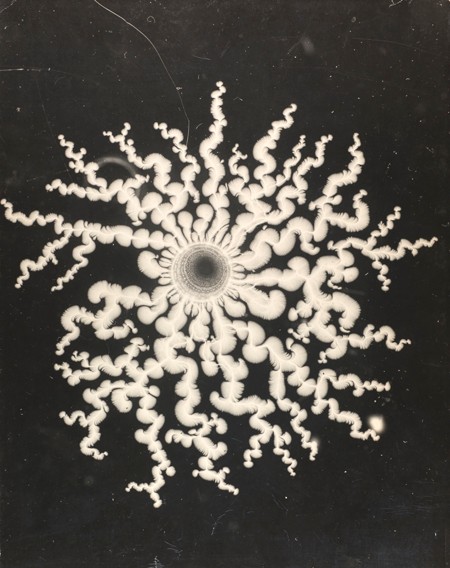A photographic panel created by the artist, designer, and visual theorist György Kepes (1906–2001) depicts a fractal-like burst of electricity exploding across the picture plane. The fantastical image is otherworldly, even supernatural. Kepes discovered the pattern—called a Lichtenberg figure after the eighteenth-century scientist who first created such images—in the laboratory of physicist Arthur R. von Hippel at the Massachusetts Institute of Technology (MIT). Von Hippel originally produced it as part of his research on electrical insulators, a field of study supported by the US government for its applications in military technologies. Through
My dissertation explores this and many other encounters between art and science during the Cold War by examining Kepes’s unusual interdisciplinary projects, including his photographs, paintings, drawings, exhibitions, books, writings, lectures, and the research institute he established at MIT, the Center for Advanced Visual Studies. Faced with a crisis of confidence in the contemporary relevance of the arts, Kepes cultivated collaborations with the sciences at Chicago’s New Bauhaus and especially at MIT, where he taught from 1946 until his retirement in 1974. I consider questions that defined Kepes’s career in the United States but are no less relevant today: Can the “two cultures”—art and science—actually work together for a common purpose? Or are they fundamentally incompatible, condemned to mutual skepticism of their respective motivations and methodologies? What is the purpose of art in a world dominated by science and technology?
In considering these issues, I build on but also depart from previous Kepes scholarship, which typically revolves around the theme of instrumentality: the ways in which his project became part of a burgeoning military-industrial-aesthetic complex that emerged in the United States at midcentury. Scholars have described Kepes’s ambition as a reactionary glorification of the imagery and ideology of science. While I do not ignore the regressive associations of his work, I also consider its progressive potential and provide a more nuanced, if conflicted, account of his contradictory practice.
My study uses new archival evidence to put forth two major arguments. I demonstrate how Kepes developed a hitherto unrecognized paradigm for aesthetic practice in a scientific context: what I call the “artist under technocracy.” This figure operated within rather than against a scientific institution; seeking refuge, he retreated from the art studio to the research laboratory. But I argue that the artist under technocracy is not entirely compromised by or fully complicit in the militaristic logic that governs his new setting. I examine how Kepes instead navigated the Cold War establishment through the artful infiltration of its protocols, manipulation of its tools, and appropriation of its discourses. Kepes uniquely embodies the complicated negotiations required for
Moreover, I situate Kepes as the major artistic figure within a startling constellation of technical experts engaged in sophisticated weapons research. This milieu was on the vanguard of advanced science, but also, in a way, advanced art. A surprising array of specialists thus became very real if entirely improbable partners in Kepes’s projects; these included the metallurgist who prepared plutonium for the first atomic bomb, the engineer who made one of the earliest digital computers for the US
I track these two themes across four chronological chapters. I examine Kepes’s study of camouflage during World War II; his development of visual design at MIT in the 1950s; his work in the 1960s on an unfinished and unpublished magnum opus he called “The Light Book”; and the center he founded at MIT in 1967. Through Kepes, my study ultimately provides a genealogy for contemporary phenomena that cross disciplines and that are commonplace in both the academy and the art world today, such as the study of visual culture and the use of new media.
